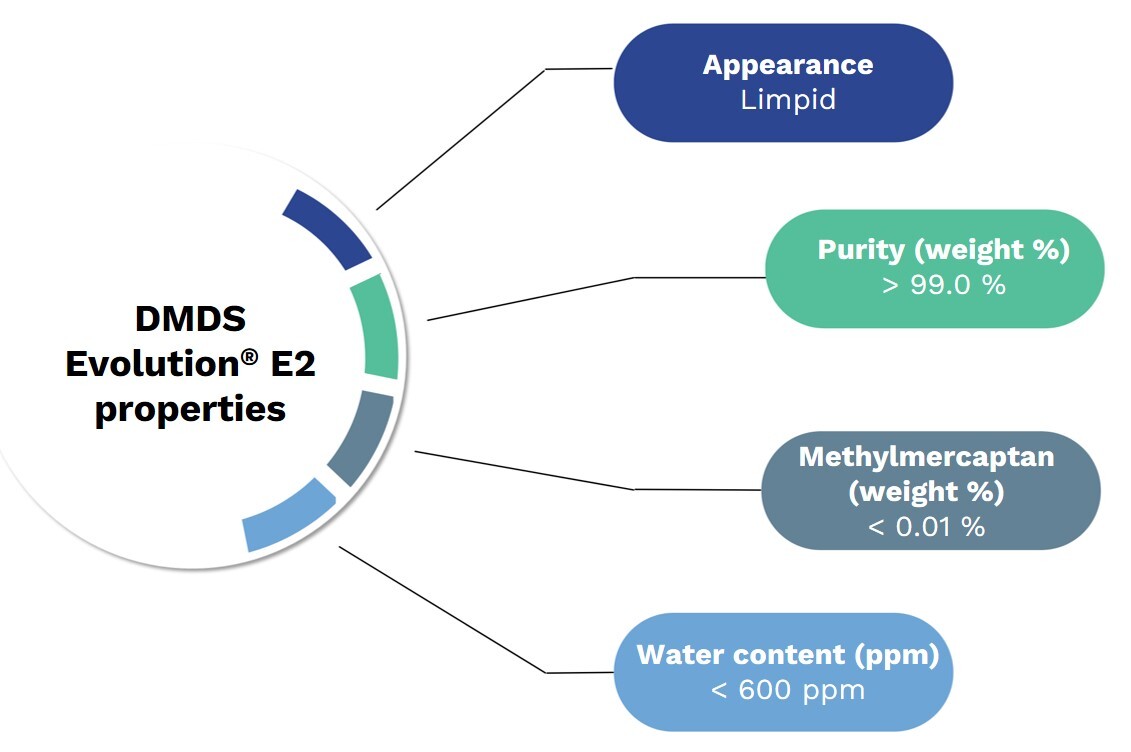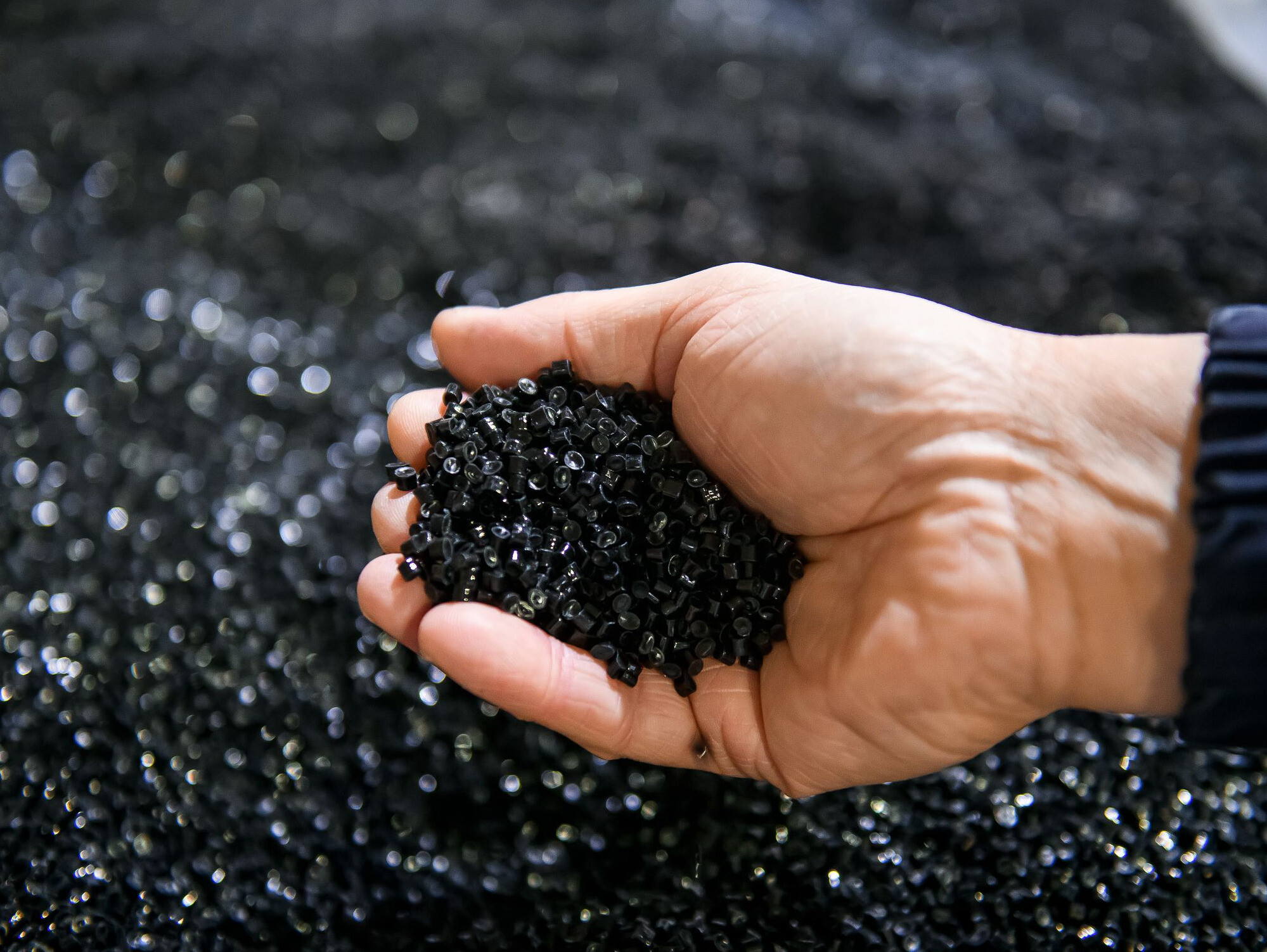DMDS Evolution® E2, the most efficient sulfiding and anticoking polysulfide
Dimethyl disulfide, DMDS Evolution® E2, only available from Arkema, is a breakthrough formulation for a better user experience on-site, providing a pleasant fragrance. It is successfully adopted as the standard sulfiding agent of choice at refineries and renewable fuel plants, as well as an anticoking agent for PDH and BDH (Propane and Butane dehydrogenation units) and steamcrackers.
- Worldwide
With over 40 years of experience in manufacturing DMDS, and world class industrial sites in 2 different continent, Arkema is the worldwide leader in DMDS (Dimethyl Disulfide) production and related services. Its unique global logistic footprint ensures the shortest and most reliable supply to major steamcrackers and refineries. DMDS Evolution® E2 production is ISO 9001- and ISO 14001-certified.
Arkema offers a full package service for catalyst sulfiding application at refineries, called Carelflex®, which consists of DMDS Evolution® E2 delivery, experienced teams as well the latest monitoring and injection equipment.
What is dimethyl disulfide, and what are its physical properties?

What are the chemical properties of DMDS Evolution® E2?
- Liquid over a wide range of temperature: DMDS (Dimethyl Disulfide) remains liquid in a large range of temperature (from -85 °C to 109 °C), which makes it easy to handle, transfer and inject.
- The highest sulfur content on the market: With a sulfur content of 68 %, DMDS Evolution® E2 is the standard sulfur carrier available to reduce coking in your steamcrackers and for hydrotreating catalysts sulfiding in refineries.
- Outstanding performance with superior scent: DMDS Evolution® E2 is a breakthrough formulation for outstanding odor control and safe handling operations. It provides a pleasant fragrance.
- High solubility: DMDS evolution® E2 shows a high solubility in hydrocarbons for a perfect reaction on all hydrotreatment catalysts.
- Perfect vaporization profile: With a boiling point of 109 °C, DMDS Evolution® E2 ensures an homogenous distribution in all steamcracking processes.
- Oustanding performances for Hydrodesulfurization, anti-coking applications for both steamcracker and propane & butane dehydrogenation, as well as hydrotreated vegetable oil units.
How does DMDS Evolution® E2 compare to other sulfiding and anti-coking agents on the market?
When compared to other sulfiding and anti-coking agents, DMDS Evolution® E2 stands out for its reactivity, dosage efficiency, anti-coking performance, stability, environmental impact, versatility, and safety considerations. These unique properties make DMDS Evolution® E2 a compelling choice for industries seeking effective solutions hydrotreatment catalyst sulfiding and steamcrackers anti-coking challenges.
- Reactivity: DMDS Evolution® E2 exhibits high reactivity, enabling efficient sulfiding of catalysts and surfaces.
- Dosage Efficiency: DMDS Evolution® E2 typically requires lower dosages compared to other sulfiding agents, thanks to a higher sulfur content. This characteristic allows for cost-effective catalyst sulfiding and steamcrackers anti-coking treatment, reducing chemical consumption and logistic expenses. Moreover, with its low viscosity, DMDS is easier to inject than other sulfiding agents.
- Anti-Coking Performance: DMDS Evolution® E2 demonstrates excellent anti-coking properties by preventing the formation of coke deposits on steamcrackers furnace coil surfaces. Its protective layer inhibits coke formation, extending the furnace lifespan and improving process efficiency.
- Stability: DMDS Evolution® E2 remains stable under normal storage and handling conditions, ensuring its effectiveness over time. It can be stored and transported without significant degradation or loss of reactivity.
- Environmental Impact: DMDS Evolution® E2 is a soil biodegradable compound, minimizing its environmental footprint. It naturally breaks down and does not persist in the environment. Furthermore, its high efficency contributes to reduced chemical waste generation and lower the logistic carbon footprint.
- Versality: DMDS Evolution® E2 finds applications across a wide range of industries, including refineries, steamcrackers, biofuels, iron steel mills as well as crop protection. It effectively addresses sulfiding and anti-coking needs in diverse processes, it is also a good intermediate for sulfonyls and shows interesting disinfecting properties as well, all these performances showcase its versatility.
- Safety Considerations: Arkema Thiochemical know-how makes DMDS Evolution® E2 safe to operate. It has a high flashpoint, reducing the risk of flammability during storage and handling. Arkema provides a full range of customized packaging and connections that will enable a safe handling adapted to every industrial environment.
Which sulfiding agents to choose for hydrotreatment catalyst activation?
The choice of the sulfiding agent is the primary step, to optimize the sulfiding process. For hydrotreatment catalysts activation, when comparing two different sulfur compounds available on the market DMDS is well headed, in terms of benefits: it is the sulfiding agent with the highest sulfur content that provides the highest activity.
READ THE ARTICLE
Understanding the Sulfiding Process with DMDS Evolution E2
Sulfiding is a critical step in the activation of hydrotreating and hydrocracking catalysts. It involves converting metal oxides on fresh catalysts into their active sulfide forms, enabling them to accelerate essential refining reactions. As a global leader in sulfur chemistry, Arkema offers DMDS Evolution® E2, a high-performance sulfiding agent designed to ensure safer, more efficient and controlled sulfiding operations. Whether you're sulfiding your catalyst during unit at the end of the turnaround or maintaining catalyst activity during its life cycle, understanding the fundamentals of the sulfiding is key to optimizing performance and ensuring safety. Below, we address common questions about catalyst sulfiding, including its purpose, process parameters and best practices.
What is a sulfiding agent?
A sulfiding agent is a chemical compound used to convert metal oxide catalysts – such as molybdenum or cobalt - into their active sulfide form (e.g. MoS2, CoMoS). This reaction is essential for initiating, and maintaining, optimal catalytic activity in hydroprocessings units, (hydrotreating and hydrocracking). Dimethyl disulfide (DMDS) is widely used due to its high sulfur content, clean decomposition, and ease of handling, making it a reliable choice for controlled sulfiding.
What is ex situ sulfiding?
Ex situ sulfiding is a process in which hydroprocessing catalysts are sulfided outside the reactor, typically at a specialized facility, before being loaded into the unit. This process involves exposing the catalyst to a sulfiding agent. Once the desired level of sulfidation is achieved, the catalyst is cooled and transported to the refinery, where it will be heated again, with careful packaging and handling to preserve the sulfided state and avoid exposure to air or moisture. Typically, ex situ catalysts are dedicated for specific operation where in situ sulfiding may be less feasible or for really smalls units, which mitigates inherent risks of these hazardous sulfided catalysts.
Why catalyst sulfiding is required?
Catalyst sulfiding is essential to convert inactive metal oxides into their active sulfide forms. Without this conversion, the catalyst would remain ineffective, leading to poor conversion rates, reduced selectivity, and shorter operational life. Proper sulfiding enhances catalysts activity and ensures safer and more efficient plant operation.
What is the purpose of sulfiding catalyst?
The primary goal of sulfiding a catalyst is to activate it for specific chemical reactions, particularly in hydroprocessing. Sulfided catalysts accelerate the removal of impurities such as sulfur, nitrogen, and metals from fossil hydrocarbon and renewable feedstocks. An optimized sulfiding process with the right sulfiding agent also helps reduce coke formation, improves catalyst activity, and helps maintain optimal operating conditions throughout the unit’s cycle.
Additional Key Concepts
- Sulfiding process: This involves the optimized injection and monitoring of a sulfiding agent, such as DMDS Evolution® E2, into the reactor at defined temperatures and flow rates.
- Injection flow rate: The injection rate of the sulfiding agent is a critical parameter. It must be precisely adapted to catalyst volume, sulfur requirement, and operating conditions. An optimized injection flow rate ensures complete sulfiding while avoiding risks such as thermal runaway and catalyst reduction or sulfur loss, which could compromise the catalyst integrity or result in a regulatory fine.




